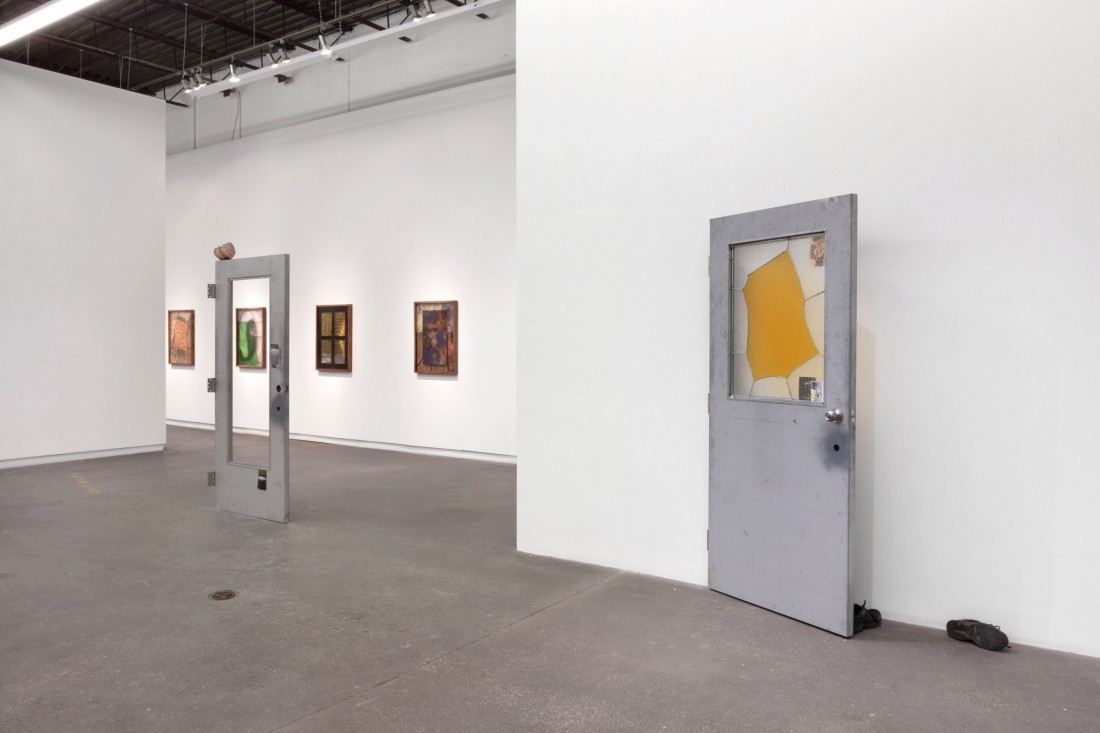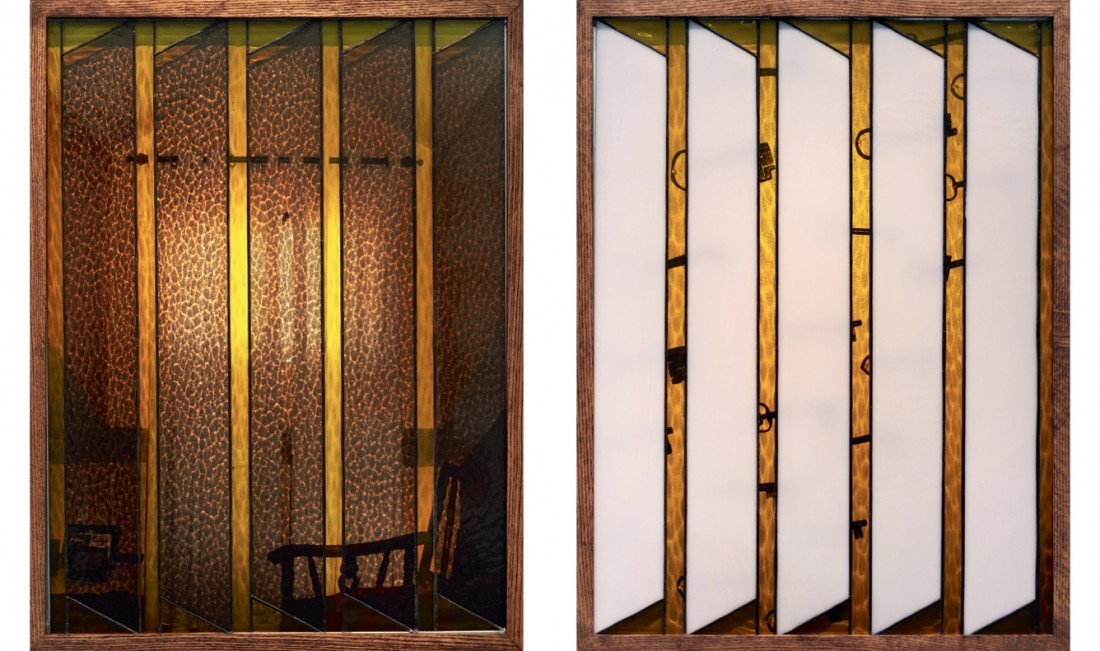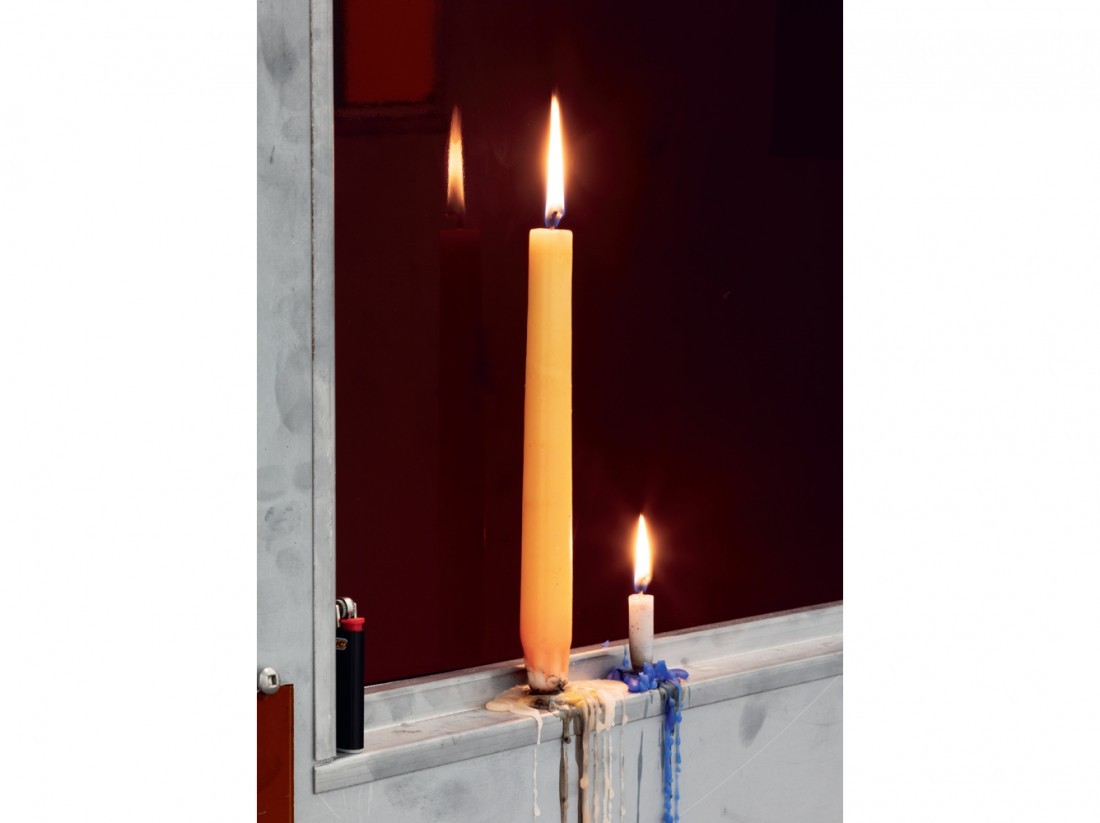Where Mystery Leans on the Side of Suspicion
An Interview with Nadia Belerique
When she is thinking about art, Toronto-based mixed-media artist Nadia Belerique holds in her mind both space and material; for her, material is content, while space is context. The former leads to photography and the latter to sculpture and installation. What is most apparent in her exhibitions is that these components are all in some kind of traceable interaction. As she says in the following interview, “I think about installation and about photographs in three dimensions. So the room you’re in is a photograph and you walk right into it.”
Belerique says that arranging what goes where in any of her walk-in photographs is her favourite part of artmaking. In “On Sleep Stones,” her 2018 exhibition at the Grazer Kunstverein in Austria, viewers encountered extremely tall steel tables on top of which sat various objects. In one corner, there was a collection of glass bottles sitting on cement, but what was most conspicuous was the delicate lavender carpet on which the artist’s footprints, revealed through Liquid Light, were in evidence. In “The Weather Channel,” her 2018 solo at the Oakville Gallery’s Gairloch location, she reprised her long-legged steel table sculptures, but this time they spilled over from one room into another. The tables, which have become a signature, were more accident than intention. They were initially intended as an apparatus to accommodate her picture taking and only after their manufacture did she realize that they could function as independent sculptural objects. They are joined in the installation with an assortment of oddments, including two table lamps, Plexiglas, electrical cords, a pair of trousers, shoes and steel keys rendered in finger and body scale, the largest pair of which lay on the floor with water-jet-cut steel faces in profile. The inclination was to read the two physiognomies as a key to the meaning of the exhibition. As metonyms, they stood in for something. The feeling you get in a Belerique installation is that the objects are clues to a mystery that remains just outside your reach. This bewilderment results from her constant interest in conflating the visible and the invisible and in deliberately confusing different registers of representation. It is an engagement of looking at something and coming to the recognition that what you’re taking in is not the thing you are looking at.

“There’s A Hole in The Bucket,” 2019, installation view, Daniel Faria Gallery, Toronto. All images courtesy the artist and Daniel Faria Gallery.
The apprehension is inescapably connected to the movement of your own body. As a spectator, you’re like a camera, as Belerique puts it, “enacting a still version of a moving image.” Her installations are locations you move through, looking for connections between one kind of object and another. This was most apparent in “There’s A Hole In The Bucket,” her third solo exhibition at the Daniel Faria Gallery in 2019, in which seven fire doors did double duty as objects that both framed and interfered with our apprehension of other objects in the gallery space. If you look through a piece called Body Farm, you can see one of the many inkjet photographs mounted to Dibond that are part of the exhibition; in this viewing the fire door is a framing device that focuses your attention on the photograph. If you take a step towards the left, the centre of the door goes blank and on either side you see interrupted sections of My Middle Name and Hybrid Horses For Your Future, two other inkjet photographs. Belerique’s intention in this exhibition was to investigate what she called “notions of separation,” and all the objects play a role in that incomplete process of understanding our relationship to the things around us. What rescues the viewer from frustration is her investigation of the possibility of oozing “visual pleasure.” What is most appealing about her work is that she is able to organize different degrees of ooziness, from the spare elegance of her inkjet photographs, to the cantilevered perspective looking up at her tabletops, and from her unlikely combinations of stained glass, soldered lead, resin, plastic flowers, glass balls, candles, feathers and stickers, to the mystery of her silhouetted, rolled steel cut-outs. Each of these delivers a different kind of pleasure. You could call Nadia Belerique’s lucid camera work the pleasure of the vexed. The following telephone interview was conducted to Toronto on April 13, 2020.
Border Crossings: You seem to view space as a container in which you could enact things, objects and situations. From the get-go you had a sense that space was really a frame for you rather than a space into which you moved.
Nadia Belerique: The seeds were planted when I was in my MFA program because it was the first time that I had a studio space of my own. I started to think about space differently. It was the opportunity of having the space and time to look at things I was making in a more material sense, and what happened when certain materials were isolated, or what they did in relation to other things. I was beginning to think about them as more performative than I had before.
It is interesting to hear you use the word “performative” because I sense that your objects and images perform in space, as if they’re enacting some narrative or story.
I started thinking of photographs as being useful. They could do things.
You have said that you love content and mystery, which leads me to ask if there is some implicit, if not explicit, story that needs to be uncovered. How do you regard this notion of story, clue, hint and mystery?
With probably only some slight shifts, my feelings about mystery have remained consistent. But I don’t know that I would use the word “story.” Maybe “narrative,” though it would be very difficult for me to illustrate which narrative I am trying to tell. I like the fact that there are clues, like with the carpet and the footprints in “Have You Seen This Man.” The mystery is in both the references and the symbology. I am using certain tropes to indicate that there is some presence or some thing that is not quite seen but that is as interesting as what you can see. In that sense, mystery is a tool and a strategy. To me, invisibility is just as important as visibility. I’m interested in conflating those two things all the time.
“Have You Seen This Man” is an appropriate choice because it contains your signature figures and footprints. Whatever is going on seems to push towards the idea of psychodrama.
Psychodrama is fine, but I don’t want it to be entirely serious. Psychodrama suggests something really dark and I don’t think it has to be that dark. The idea is that the footprints were made by these static figures or by some object that moves when you’re not looking. So the tone can be absurd and maybe even hilarious. Dark and funny.

Left: My Middle Name, 2019, inkjet photograph mounted to Dibond, stained glass, lead, artist’s frame, 33.5 x 25.5 x 2 inches. Right: Blinds, 2019, inkjet photograph mounted to Dibond, stained glass, lead, artist’s frame, 33.5 x 25.5 x 2 inches.
Using Liquid Light is a conspicuous nod in the direction of a narrative of some kind. My inclination is to ask, “Whose footprints are those; when were they made; and why are they here?”
Yes. I’ve always liked the idea of some kind of cinematic scene. I think more in terms of the cinematic moods and tones and chords that I’m trying to strike and I like the idea of enacting a still version of a moving image. You can experience something when you’re walking through space that suggests movement while in fact everything is completely still. Of course, it is the viewer who is moving. So the movement of the body is one of the things that I like to explore and highlight. To say you are always moving is a banal statement, but there is something profound about the banal, which is another thing I like to explore in my work.
Are the figures surrogates or stand-ins?
I think of everything as a stand-in, even the photographs. The figures started out as references to cardboard cut-outs. Previous to “Have You Seen This Man,” I had the opportunity to do a one-work show at Gallery TPW in this weird interstitial space between permanent locations, a storefront on Dundas. I thought it would be funny to insert a cardboard cut-out in the storefront, so I photographed two views of a cut-out of Deanna Troi from Star Trek, one from the side and one from the back. I then mounted these to Coroplast. Titled The Counselor, they really appear as cardboard, but they are in fact just photographs reprinted to scale. This work was a precursor to the metal versions I made very soon after for “Have You Seen This Man.” These metal ones were made the same way I made The Counselor, side and back views of cardboard cut-outs, but without a photograph. You see them as blank, so you have to imagine the photograph that I wanted you to look at as something and at the same time I tell you it is not that. I think there is something interesting in looking at a picture of a flower and saying it is not about a flower.
When I was a film critic for CBC television in Winnipeg, everyone wanted to take the life-size cardboard cut-outs of the actors from the theatre lobby.
With the Deanna Troi image I was interested in the fact that people collected these free-standing figures and the relationship they had to all photography. I loved the idea that those cardboard cut-outs would glow like someone but in a clumsily sincere way. It says a lot about scale and what photography can and can’t do. I also liked the references The Counselor made to psychology and the fact that she was an empath who could “feel you.” At the time I was going through psychoanalysis myself and I had this hilarious thought that she was as good as my psychoanalyst because she never said anything and neither did mine. My idea was that you could have a relationship with this non-speaking cardboard cut-out because she still does the job. It was a way of possessing something but in a really unabashed way. I think that is what all photographs are trying to do.

Neighbourhood Watch, 2019, detail. Fire door, stained glass, lead, found objects, 79.5 x 35.5 35.5 inches.
Do you think of yourself as primarily a photographer?
I don’t consider myself a photographer, but something about my relationship with printed images carries through my work. Mostly I think about installation and about photographs in three dimensions, about the idea that a photograph is actually blown up into three-dimensional space. So the room you’re in is a photograph and you walk right into it. And I do think about photographs all the time. I take pictures and I think about going between two and three and four dimensions—all these things, all the time. So it is space in relation to the photograph, which was my first love.
…to continue reading the interview with Nadia Belerique, order a copy of Issue #154 here, or Subscribe today.

